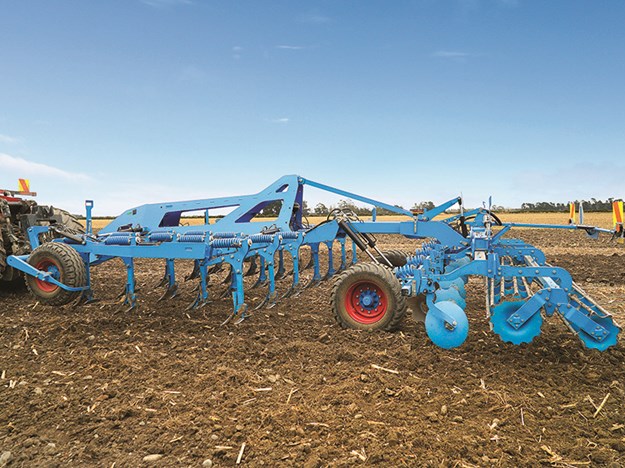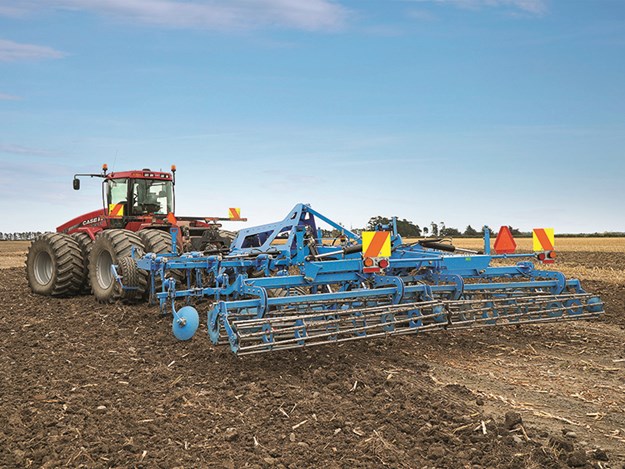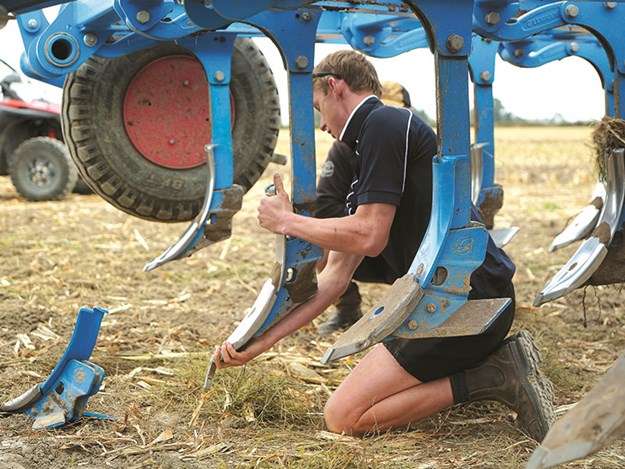Put to work on stony soil, the Lemken Karat 12 cultivator proves to be a versatile and clever machine that comes with a range of options to suit the application
Having managed a trip to Canterbury for a visit to Euroagri prior to the lockdown, my focus was on checking out the German-made Lemken Karat 12.
 |
|
While it may not look like a complex machine, the design is exceptionally clever
|
Bear with me, as it may be a little confusing, but there are two options of the machine here: the Karat 9 and Karat 12, and this has nothing to do with working width.
The Lemken Karat 12 is the longer version, due to an additional row of legs. There are four rows on the Karat 12, and three rows of legs on the Lemken 9.
Our test machine for the day was the six-metre version of the Karat 12. There’s only one version larger – the seven-metre, which is rated up to 600 horsepower (447kW). We had 535hp (399kW) on the six-metre.
In some ways, when you first see the machine folding up in the transport position, there’s a lot of daylight. It’s not a complex machine, but it’s well-built and cleverly designed. So, initial thoughts are around how such a seemingly simple machine sucks up 535hp?
Well, this is where the clever part comes in.
With the Lemken Karat 12, you can work to a depth of 30cm. While this over six metres will drag most machines to their knees, the four rows of legs really penetrate and smash any compaction. After the legs, a set of levelling discs keep the surface in check while the double cage roller incorporates any leftover stubble.
.jpg) |
|
The first pass in maize stubble
|
Legs
Having also taken a look at the Lemken Rubin on this same trip, one of the things that most impressed me with the machine was the large sections of profile cut steel. This added significant strength to the machine without making it ridiculously heavy.
The Lemken Karat is similar, meaning you’re not using diesel and wearing tyres simply dragging additional steel around the paddock.
How then can 25 legs deliver up to 550kg of downforce per leg from a machine that only weighs 6,500kg? The answer is that the results don’t simply come through sheer weight, but instead through the well thought-out design and shape of the leg.
The large coil spring on each leg delivers two results. First, the leg springs back slightly to penetrate the ground. The spring is constantly pressing against it as the machine is pulled forward. Second, there’s an auto-reset function in case you hit stones, stumps, or the like, making it pretty much maintenance-free.
In the flat but stony Canterbury conditions we were working in, the large spring reset system came into its own. You can see these things chattering along, allowing the machine to rip and break up the pan but without bringing all those stones to the surface.
 |
|
The rear row of levelling discs
|
Quick hitch points
This is not the technical name for the tips, but they work just like a quick hitch and are, by far, my favourite feature of the Lemken Karat 12. For the test set-up, we had a large centre shin point with wings at the base.
These are carbide hardened (extra wear-resistant) and not only allow the ripping, boiling, and breaking of up the pan but also for the win, give you sideway shattering and a more level finish on top.
This is where the quick hitch aspect comes in and makes this machine so versatile. If you want an aggressive primary cultivator, a single shin point is the best to get stuck into some tight ground.
Then, if you want the machine to be more of a finishing tool, you could have a larger wingtip (various options are available) and the quick hitch system is initiated by removing a clever linchpin: single shin off, winged point on, pin back in – how good!
To protect the legs themselves, there’s a deflector. This stops the punishing stones and abrasive soil hacking away at the more expensive-to-replace legs.
 |
|
The double caged rear roller has a clever mounting point, with a pivot point above the rollers
|
Rear roller options
Like all Lemken machines, there are various options, and the rear roller is no different. The double caged roller spec’d on our test machine had a clever mounting point that isn’t fixed in the middle, but the pivot point is above the two rollers.
This works like a walking beam on a trailer and, when you come up to an obstacle in the paddock, the two rollers then just roll over (no pun intended) the obstacle as a walking beam would through uneven tracks, rather than violently bouncing out of the ground.
The roller is easily removable, simply done by three sections of four bolts. You may want to remove it if it was wet or you didn’t want to use it to consolidate a paddock, or just like the points you might want to have two different types of rollers for seedbed preparation. Again, it’s almost like a kit set design with many options.
 |
|
Demonstrating the ease of swapping out the interchangeable tips
|
Optional contour system
With the contour tracker, if you’re going through humps and hollows, the ram for depth control on the roller goes in and out to keep consistent depth regardless of contour.
The traction booster meanwhile is a clever three-point linkage system, where another large drawbar ram and the rear contour tracker ram work in conjunction through accumulators. When there’s pressure on the traction booster if the tractor is going up a hill, but the machine hasn’t quite hit that hill yet, the traction booster sends that oil from the front ram and is adjusted accordingly on the rear ram.
It’s a clever system that also allows pressure to be put back onto the tractor, hence being a traction booster.
The top link of the three-point system can be loaded up (from the large, easy-to-read dial in view from the cab), allowing weight to be put back onto the tractor to try and balance the 50/50 weight distribution most tractor manufacturers aim for, through the force that the cultivator is generating being dragged through the ground to be transferred back onto the tractor.
This also allows you to move weight from the front wheels to the back from the rear roller or from the rear of the machine to the front of the tractor, depending on where you’re losing traction in the field.
.jpg) |
|
A bird’s-eye view of the Case IH Steiger and Lemken Karat 12
|
Luckily, we were on the tabletops of the Canterbury Plains so didn’t need either the traction booster or the contour tracker. Instead, we had a normal drawbar mount and the more manual roller and front touch wheels on a single hydraulic system. This allows adjustments to be made while continuing consistent depth along the length of the machine.
The mid-transport wheels allow the machine to quickly lift at the headland. It also allows for tight turning because the wheels are not offset to the back. The frame and lifting pendulum are ergonomically designed so they tuck up flush with the frame. This allows that 30cm of depth but also a long ram stroke to get those legs up out of the ground at the headland.
Summary
I think the word for this machine to sum it up is ‘clever’ – that’s a more accurate description than complex. It’s unarguably well built and innovative and performs not only in the paddock but is also easy to live with, as it’s so versatile and the wearing parts are easy to replace.
The other real benefit, due to the versatility, is that you don’t need to buy two different machines, just this one, which is a combination of an actual cultivator and a big life-size piece of Meccano.
Photography: Justin Bennett

